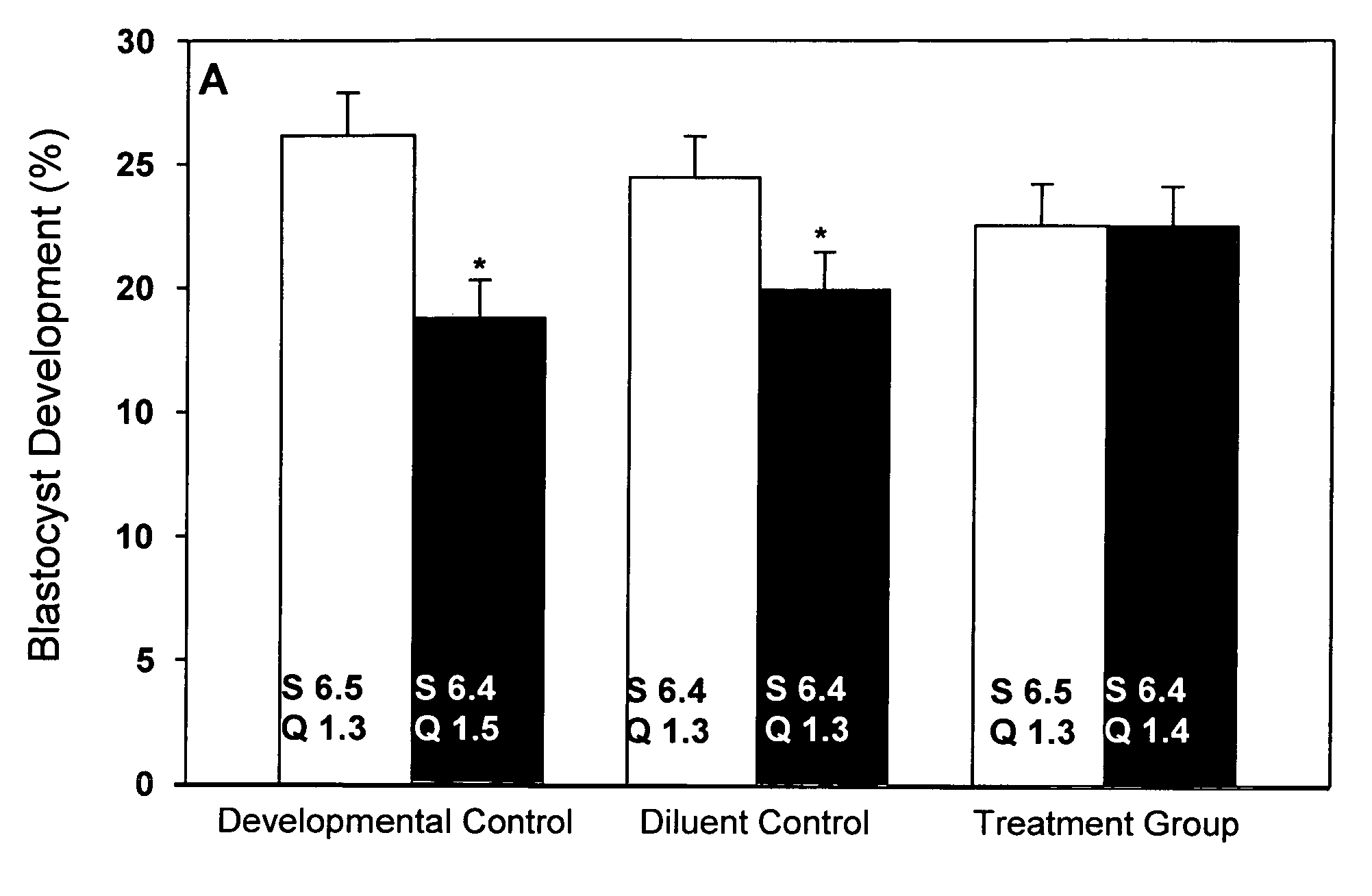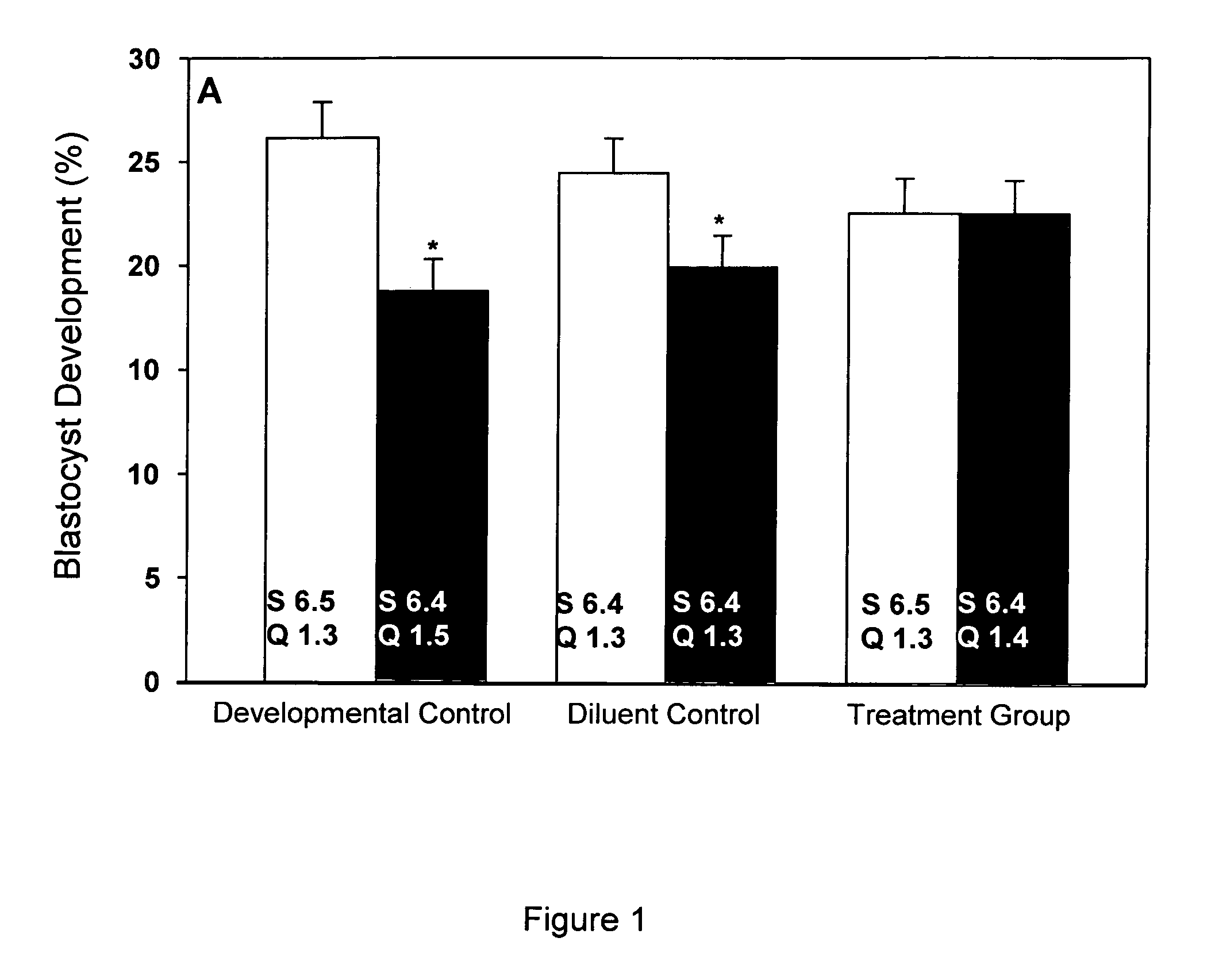Embryo development and survival
a technology of embryo development and survival, applied in the field of in vitro fertilization and embryo transfer, can solve the problems of early embryonic loss, loss, and serious embryonic loss
- Summary
- Abstract
- Description
- Claims
- Application Information
AI Technical Summary
Benefits of technology
Problems solved by technology
Method used
Image
Examples
example 1
Compacted Embryos
[0042]In vivo-derived glycerol-frozen morula-stage bovine embryos are thawed utilizing a three-step glycerol removal procedure. After washing, embryos are allowed to regain normal morphology for 30 min in Vigro holding medium and are sorted by stage of development and quality according with the IETS guidelines for classification of bovine embryos. For this study, a total of 4 replicates are used.
[0043]Schrick, et al, Biol. Reprod. 49:617-621 (1993) reported 0.64 ng / mL of PGF2α in flush media from short cycle cows and a negative association of PGF2α concentration with embryo quality. Based on these findings, concentrations of 0 (control, KSOM-PVA), 0.1, 1, and 10 ng / mL of PGF2α in culture medium are selected as treatments. Each treatment is placed in a different well of a 4-well plate (500 μL / well) and then maintained in the incubator (5.5% CO2, 7% O2, and 87.5% N2 at 38.5° C.) for at least 5 h before placement of embryos to allow equilibration of medium. At the same...
example 2
Presence of PGF2α Receptor Transcripts in Morula-Stage Embryos
[0046]Embryos are produced in vitro as described above. On day 6 of embryonic development, morula stage embryos are transferred to an “X” plate containing pre-warmed PBS supplemented with 0.1% PVA (polyvinyl alcohol, Sigma; St. Louis, Mo.). Embryos are washed twice in the same solution and then placed in a 1.5 mL RNAse-free eppendorf tube containing 50 μL of RNA later solution (Ambion Inc., Austin, TX). Pools of approximately 20 embryos in RNA later are kept at 4° C. overnight and stored at −80° C. until RNA isolation and further processing.
[0047]The Absolutely RNA Nanoprep Kit (Stratagene, La Jolla, Calif.) is used to isolate highly pure total RNA from bovine embryos as described by the manufacturer's instructions. In order to decrease the viscosity of RNA later, 70 μl of nuclease free water are added to each sample. Samples are spun at 7,000 g for 5 min and the supernatant removed. Embryos are then lysed by addition of ...
example 3
Effect of a PGF2α Receptor Antagonist on In Vitro Development of Embryos
[0053]Pre-compacted 16- to 32-cell stage bovine embryos (day 4 post fertilization) are washed in KSOM-PVA and divided into four groups, each of which is cultured for 48 hours in KSOM-PVA containing one of the following: (1) 1000 nM AL-8810, n=95 (AL-8810 group); (2) 1 ng / ml PGF, n=91 (PGF group); (3) 1000 nM AL-8810 +1 ng / ml PGF, n=90 (AL-8810 +PGF group); or (4) KSOM-PVA without AL-8810 or PGF, n=84 (Control group).
[0054]Following the 48 hour culture, embryos from each group are placed in HEPES-TALP and embryonic development is assessed by a technician who is uninformed of the treatments of the embryos in each group. Embryos from each treatment group are washed in KSOM-PVA and transferred to a 4-well plate with KSOM-PVA for further culture until day 8 post fertilization, when embryonic development is again assessed.
[0055]Data indicates that addition of PGF on days 4 to 6 decreases the percentage of embryos reac...
PUM
| Property | Measurement | Unit |
|---|---|---|
| concentration | aaaaa | aaaaa |
| concentrations | aaaaa | aaaaa |
| concentrations | aaaaa | aaaaa |
Abstract
Description
Claims
Application Information
 Login to View More
Login to View More - R&D
- Intellectual Property
- Life Sciences
- Materials
- Tech Scout
- Unparalleled Data Quality
- Higher Quality Content
- 60% Fewer Hallucinations
Browse by: Latest US Patents, China's latest patents, Technical Efficacy Thesaurus, Application Domain, Technology Topic, Popular Technical Reports.
© 2025 PatSnap. All rights reserved.Legal|Privacy policy|Modern Slavery Act Transparency Statement|Sitemap|About US| Contact US: help@patsnap.com


